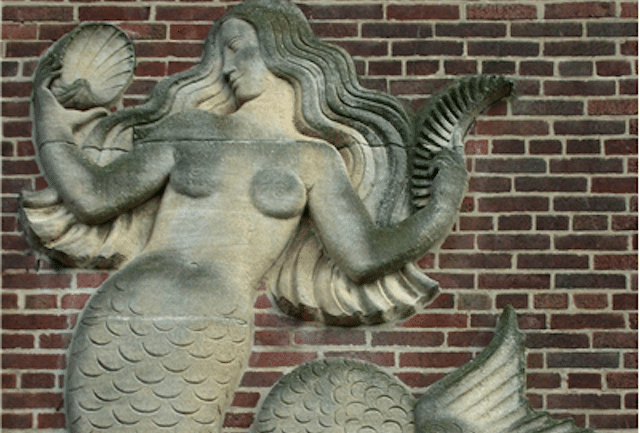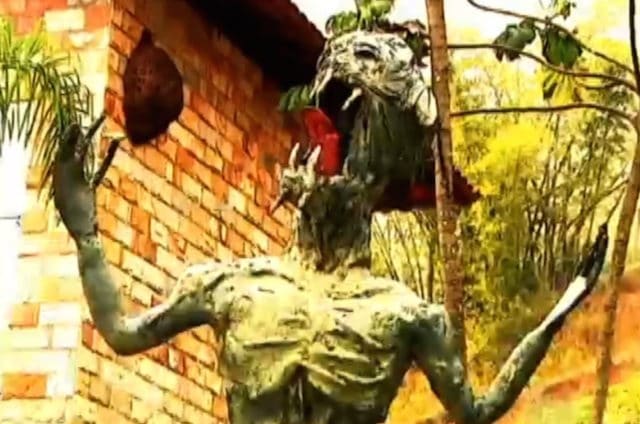Brazilian folklore is a wonderful stew of European, African, and Native American legends, flavored with exotic spices that are added and subtracted to each region’s taste. Much has been written on the subject over the years. One of the major and more recent sources is by the Brazilian folklorist Luís da Câmara Cascudo, whose Dicionário do Folclore Brasileiro (Dictionary of Brazilian Folklore) is widely cited.
But the body of work reaches as far back as the 16th century, when José de Anchieta – a Jesuit missionary, writer, and key player in early Brazilian history – mentioned in a letter certain espectros notournos (night specters), dêmonios (demons), and fantasmas (ghosts) that terrorized the Indian population. One of those demons was the…
10. Boitatá

The legend of the boitatá originates with Brazil’s native Tupi people. The word means “serpent of fire” or “fiery thing,” depending on how you translate the Old Tupi mboî-tatá. Anchieta described it as a “fiery thing” in 1560, but today the boitatá is commonly portrayed as a fiery snake.
According to the legend, there was once a long period of darkness when the sun did not shine and a deluge myth flooded the earth. These conditions killed many animals and forced the beasts to flee their natural habitat. Among the displaced survivors was the boiguaçu, a giant cave anaconda. Emerging from its lair, the boiguaçu began to eat the eyes of the dead, which shone brightly in the darkness and made for tasty delicacies. As the snake ate more and more of these delicious, shiny eyes, its body began to shine, too, but the eyes-only diet steadily weakened it, and it perished… in a blaze of glory. For, upon its death, all the light collected inside it escaped to the sun, and the dark days were finally over.
There must have been some magic in all those eyeballs, because the boitatá lived on in spirit. It inhabits the Amazon jungles to this day, often appearing at night as nothing but two glowing, fiery eyes. Some say it can breathe fire as well, an ability it uses to incinerate people who harm the rainforest by chopping trees down or starting fires. Others say it can actually disguise itself as a tree trunk, then roast alive any lumberjack who comes to cut it down. Oh, and it can also blind you and make you insane if you gaze into its eyes.
There are other versions of the legend that describe the boitatá as a giant, fiery bull who hunts the hunters, and yet others that associate it with almas penadas – souls that are cursed for various reasons, from immorality to dealing dishonestly with the devil. Many descriptions of the boitatá legend connect it with ignis fatuus, or that fiery phenomenon known as the will-o’-the-wisp. There is some overlap between the legends of the boitatá and the boiúna, an evil black snake that is said to take a variety of forms, attack and devour people, and use its flaming eyes to lead boats to their ruin.
9. Boto Encantado

The boto encantado is an enchanted Amazon river dolphin. This may sound charming and cute, but only if you’ve never beheld an Amazon river dolphin belch itself up through the waves right next to your canoe. You see, botos are fat, ugly, loud, and big enough to easily capsize small watercraft. It’s clear, even before any enchantment takes place, why people believe making eye contact with one of these guys leads to hellish nightmares.
But the real story here is the shapeshifting. In Brazilian folklore, botos transform at night from ghastly fish to handsome men and visit the drinking holes and dance halls to seduce young women. The only part of their bodies that doesn’t change, the blowhole, is always hidden underneath some kind of fashionable hat, whence springs the custom to ask unidentified dudes at the bar to remove their hats and prove they’re human. In addition to a hat, the boto is (or at least was, traditionally) described as wearing a sword, a fine belt, and white shoes. All of these items are themselves river creatures – the hat a stingray, the sword an electric eel, and the belt and shoes different kinds of fish.
One tale of the boto encantado tells of two men who spent a night drinking and carousing in town, only to disappear at dawn. The next day, fishermen caught two botos and, while gutting them, found they smelled strongly of liquor. In another case, a man was suspected of being a boto, chased to the river, and speared with three harpoons as he dived into the water. A dead boto was later found in the vicinity with three harpoons protruding from its body.
The legend of the boto is often applied in cases of uncertain paternity. Kids with unknown fathers are simply the filhos de boto, or the dolphin’s children. Problem solved!
8. Mapinguari

The mapinguari (“roaring animal” or “fetid beast”) is basically the bigfoot of South America. This cryptid is described as a giant smelly beast that can stand on its feet like a grizzly, having the face of a monkey and thick fur over skin tough enough to stop a shotgun round in its tracks. Some sources have reported it sporting a second mouth in the middle of its belly, which emits a disgusting odor that leaves men dizzy, confused, and unconscious. Often, people say the mapinguari serves as a sort of jungle protector, attacking those who take more resources than necessary. In this sense, it is similar to other legendary protector/punisher figures, like the boitatá above and the curupira, a creature with backward feet who finds joy in confusing hunters.
Some believe the mapinguari is really a giant ground sloth (Megatherium), thought to have gone extinct long ago but possibly still in endangered existence deep in remote parts of the rainforest. There are accounts of this sort of creature that span tribal groups who have no contact with each other, and many similar stories from hunters, rubber tappers, and more. The ubiquity and consistency of these reports piqued the interest of some scientists. One, an ornithologist named Dr. David Oren, has arranged expeditions to search for the mapinguari, but so far has collected zero sightings and a bunch of hair and feces that turned out to be non-mapinguari.
One member of the Machiguenga tribe in Peru told another scientist, Dr. Glenn Shepard, that he had seen a mapinguari in a museum in Lima. That museum just so happens to include a display featuring a model of Megatherium.
7. Saci

The saci is one of the most well-known Brazilian legends – it even has its own national holiday. October 31 is Dia do Saci, or Saci Day, established to direct attention away from the American Halloween tradition and toward Brazilian culture.
There are many different accounts of the saci‘s nature and powers. Or, perhaps more accurately, there are many different sacis. Each one, however, has the same basic appearance – he is a one-legged African-American boy who lives in the jungle, smokes a pipe, and wears a red hat.
While sacis are sometimes considered malicious and connected with shamanic curses, they are usually seen in popular culture as mischievous beings. The saci is responsible for minor infractions like spilling salt, burning food, scaring horses, and hiding toys. Thanks to his red hat, he can magically disappear or transform into a bird. Anytime you see a whirlwind, look out – there might be a saci inside, just waiting to test your appreciation of Brazilian culture.
There are many simple ways to counter a saci‘s “attacks” – for example, if you find yourself bothered by a saci, you can lay down a knotted rope; the saci will stop and untie the knots, during which time you can escape his attention. It is also possible to shake a saci by simply crossing a stream, as sacis dislike water and will not cross it. In addition, if you manage to steal a saci‘s hat, you will be granted a wish.
Sacis are born inside bamboo stalks and take seven years to gestate. After emerging from their weird womb, they live for exactly 77 years, then die and transform into poisonous mushrooms, or orelhas de pau, which are ear-shaped fungi that grow on the sides of trees in the rainforest. Fun fact: the bigger a saci‘s ears, the older he is.
6. Mula sem Cabeça
Like other legends out there, the mula sem cabeça (headless mule) probably arose as a scare tactic to encourage moral principles. The legend of the mula tells of a girl or woman who was cursed for having relations with a priest. As punishment for her part in a man of God’s sin, she is condemned to transform into a wild mule with fire in place of a head, shooting flames from its nonexistent nostrils and stampeding through villages at night. In the morning, she reverts to her human form, waking up naked and unable to remember a thing.
The mula is said to produce a piercing, terrifying noise during its rampage, and the clattering of its gold or silver shoes strikes fear into all who hear it. If you get too close, it might kick you into the afterlife. To successfully hide from the mula, you must ensure specific body parts are concealed from its sight, as it seems to enjoy eating eyes, thumbs, teeth, etc., depending on which version of the legend you recall while in the process of dying of fright. It’s said that you can undo the mula‘s curse by either removing the bridle from its nose or by making it bleed – both of which methods are nearly impossible, given the high probability of getting a hoof to the chest.
Some versions of the legend curse the priest instead of the woman, usually following a twist where the aforementioned relations are violently one-sided in the priest’s favor. Some also say the mula is a girl who lost her virginity outside of marriage. A third, more fantastic version involves a queen who had a bad habit of digging up kids’ graves and eating the corpses… until the king caught her in the act, whereupon she transformed into the mula and charged headlong into the night.
5. Mulher de Branco

Like most countries, Brazil has its fair share of urban legends, some of them terrifying. Take the legend of the loira do banheiro (the bathroom blonde), for instance. This legend tells the tale of a beautiful blonde girl who killed herself (or was killed) in a bathroom. Her soul is trapped there, and she must spend the rest of eternity scaring the crap out of people who show up to do their business.
There are other loira legends as well, including one that involves a blonde on the street who tricks men into giving her a lift, then tries to murder them. In addition, as with cultures around the world, there are many loosely related accounts of ghostly women dressed in white, collectively known as White Ladies, most of whom were violently killed. Some died in childbirth; others were murdered in so-called honor killings. All of them hang around the land of the living to haunt the places where they met their ugly ends, and sometimes to seduce men and lead them to their deaths.
One of the more memorable White Lady tales in Brazil is that of the cobbler’s daughter, a beautiful girl who was given in marriage to a wealthy plantation owner. One day, the plantation owner became angry with her for showing kindness to a slave. The girl’s cruel husband murdered the slave and forced her to either eat the dead man’s flesh or starve to death. The cobbler’s daughter opted for starvation and became a White Lady when she died.
4. Iara

Iara is a mermaid who seduces men with beauty and song. Most of her victims are killed by drowning; the few who survive an encounter with this siren end up going nuts.
Originally, Iara was a Tupi Indian laborer and the daughter of a shaman. She was so hardworking and brave that other workers, particularly her own brothers, became jealous. One night, her brothers ganged up and tried to end her, but she defended herself and killed them instead. Frightened, she fled to the jungle, but a search party tracked her down and tossed her into the famous encontro das águas (meeting of waters) at the rivers Negro and Solimões, near Manaus, Amazonas.
The search party left Iara to drown. However, fish floated her body to the surface, and the light of the full moon transformed her into a long-haired, green-eyed mermaid. By way of revenge, she now spends her days luring sailors into the water and murdering them, and it would seem that she’s just as good a man-drowner as a laborer.
The legend of Iara is thought to be a conflation of the European mermaid myths and an old Tupi legend of a giant, ferocious fish called ipupiara that would emerge from rivers with a vengeance to turn the tables on fishermen.
3. Caboclo d’Água

The caboclo d’água (water hillbilly) is a short, strong, one-eyed creature who inhabits the Rio São Francisco, an 1,800-mile river that runs through the Brazilian states of Minas Gerais, Bahia, Pernambuco, Alagoas, and Sergipe. He can be in multiple places at once and, if he feels like it, manifest as an animal.
The caboclo, being a beast of the water, primarily makes life hell for fishermen. When not scaring fish away from their hooks and nets, he’s attempting to flip their boats or run them aground. One account of the caboclo states that he appeared to a fisherman as a horse, floating dead in the water, but then came to life, submerged, and began rocking the boat like a madman.
The caboclo may be temporarily placated by tossing some tobacco into the water, which is how the fisherman in the case of the “dead” horse above escaped loss of his boat. Preventive measures include painting a white star on or attaching knives to your boat’s hull, and/or carving scary figures upon its prow.
It is said that the caboclo lives in a deep grotto decked with gold, but anyone crazy enough to search for this treasure – or even think about doing so – will be subject to the creature’s imminent attack.
2. Carruagem de Ana Jansen
The carruagem de Ana Jansen (Ana Jansen’s carriage) is pulled by decapitated horses and driven by a decapitated, bleeding slave. If you’re ever on the streets of São Luís, Maranhão, at night and see this atrocity, you’ll want to avoid conversation with the coach’s occupant.
Ana Jansen was a lady of power and importance in the political, economic, and social scenes of 19th-century São Luís. She was also a terrible person, the kind of person who spent recklessly and treated her slaves like… slaves. As punishment for her wanton behavior, she is condemned to forever wander the streets of São Luís, riding in her hellish carriage, usually on Thursday and/or Friday nights.
Ana is said to offer a lit candle to anyone unfortunate enough to meet her. The candle, come morning, transforms into a dead man’s bone, which we would definitely hang on to as a weapon to use against…
1. Cabeça Satânica

The cabeça Satânica (Satanic head), also known as the cabeça errante (wandering head), is a disembodied demon head that bounces or rolls along the ground, grinning a grin of evil incarnate. If you don’t go insane from the sight alone, you will after the cabeça hops up and gives you a playful little bump – which, according to legend, is all it takes to render you swiftly sick and then dead.
Most often, the cabeça shows up as a long-haired stranger in the woods at night, his back to the victim. That’s not nearly creepy enough, though, so the stranger’s body then drops straight down into the ground (and/or hell), probably a lot like the stomach of the unfortunate witness. It stops dropping at the neck, and only a shaggy cabeça remains to be seen. Smiling like a lunatic, the head turns to face its prey.
There are minor variations of this legend, one of which describes the cabeça as a kind of horror-bomb lobbed by some other evil being, who throws it at any person in range to torment them for kicks and giggles. Either way – no thanks, legend, no thanks.
3 Comments
ass
5. Mulher de Branco
Sounds like Moaning Myrtle (Harry Potter) looks like Stephen Tyler